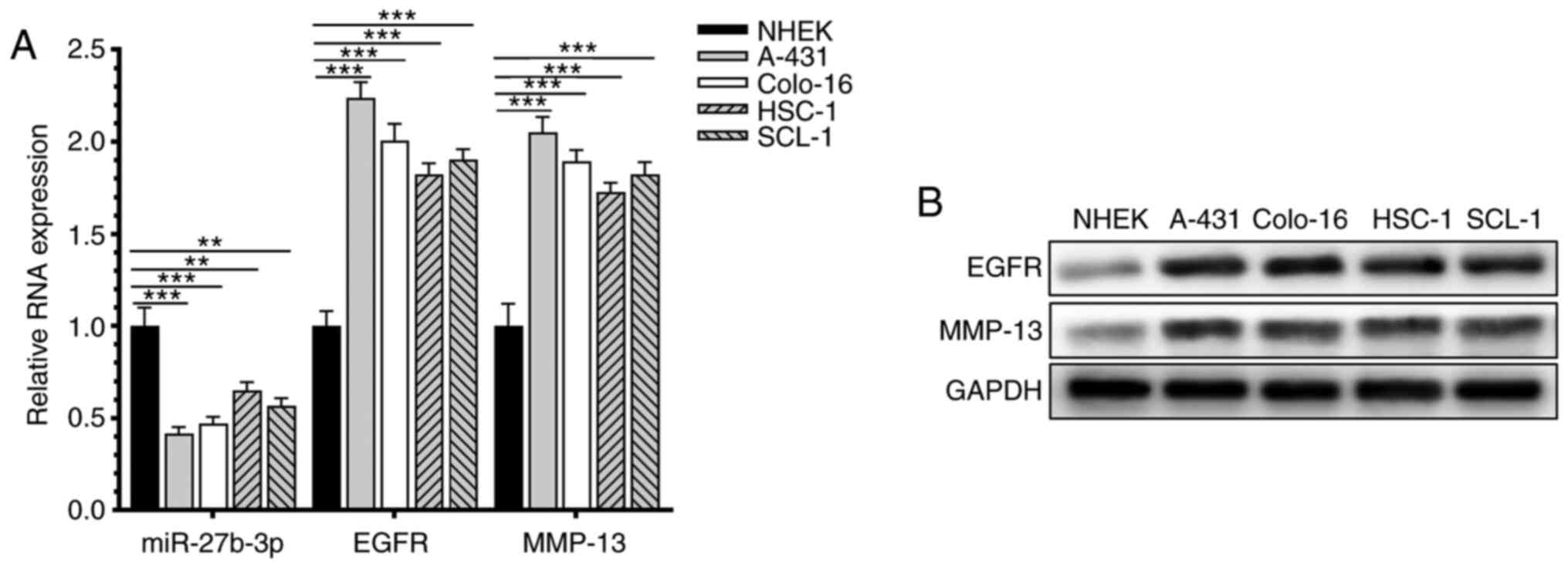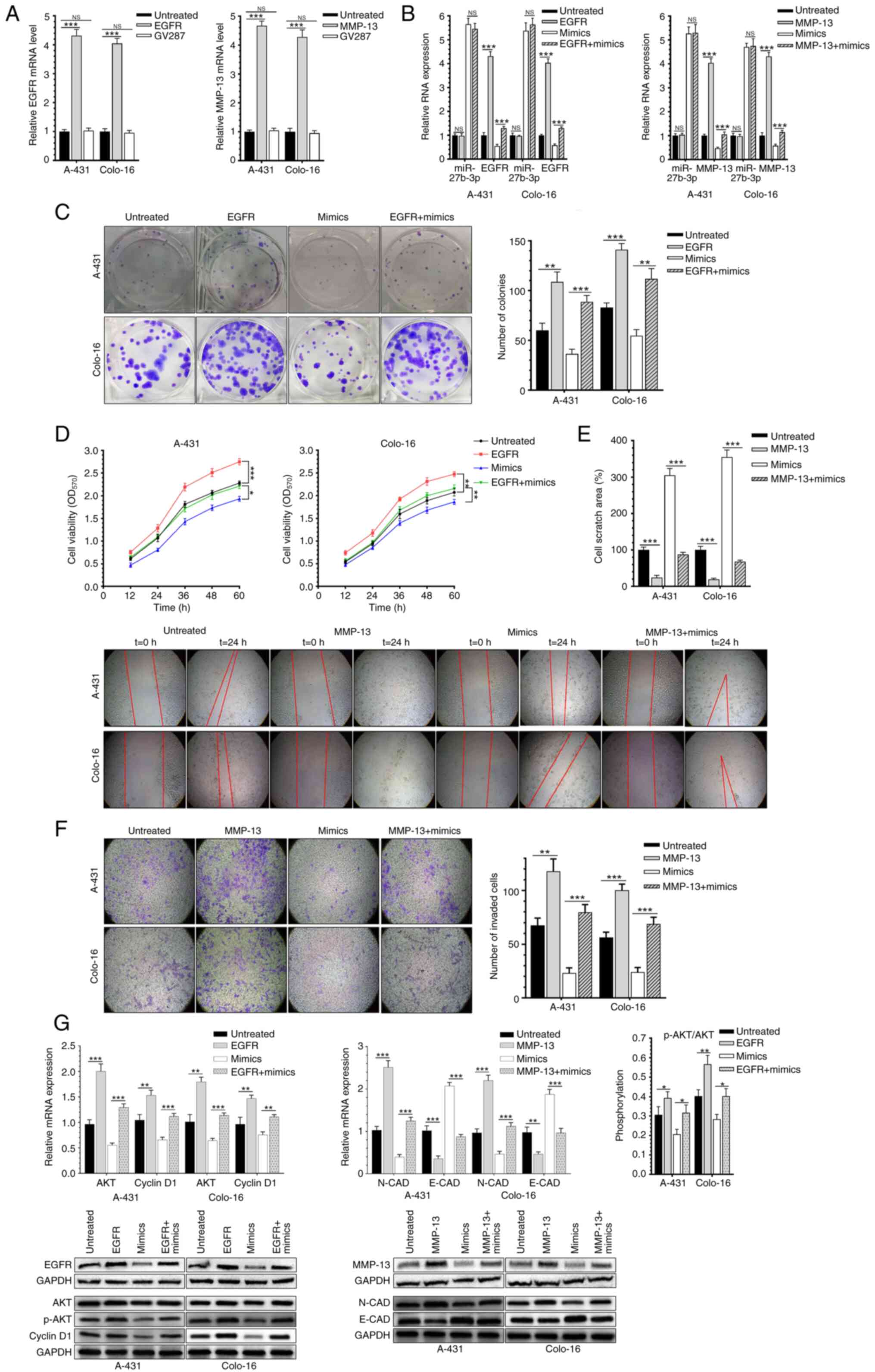|
1
|
Que SKT, Zwald FO and Schmults CD:
Cutaneous squamous cell carcinoma: Incidence, risk factors,
diagnosis, and staging. J Am Acad Dermatol. 78:237–247. 2018.
View Article : Google Scholar : PubMed/NCBI
|
|
2
|
Asgari MM, Warton EM and Whittemore AS:
Family history of skin cancer is associated with increased risk of
cutaneous squamous cell carcinoma. Dermatol Surg. 41:481–486. 2015.
View Article : Google Scholar : PubMed/NCBI
|
|
3
|
Waldman A and Schmults C: Cutaneous
squamous cell carcinoma. Hematol Oncol Clin North Am. 33:1–12.
2019. View Article : Google Scholar : PubMed/NCBI
|
|
4
|
Perera E, Gnaneswaran N, Staines C, Win AK
and Sinclair R: Incidence and prevalence of non-melanoma skin
cancer in Australia: A systematic review. Australas J Dermatol.
56:258–267. 2015. View Article : Google Scholar : PubMed/NCBI
|
|
5
|
Lee AY and Berman RS: The landmark series:
Non-melanoma skin cancers. Ann Surg Oncol. 27:22–27. 2020.
View Article : Google Scholar : PubMed/NCBI
|
|
6
|
Newlands C and Gurney B: Management of
regional metastatic disease in head and neck cutaneous malignancy.
2. Cutaneous malignant melanoma. Br J Oral Maxillofac Surg.
52:301–307. 2014. View Article : Google Scholar : PubMed/NCBI
|
|
7
|
Bowe CM, Gurney B, Whitaker S and Newlands
C: Management of regional metastatic disease in cutaneous
malignancy of the head and neck. 3. Merkel cell carcinoma. Br J
Oral Maxillofac Surg. 57:847–856. 2019. View Article : Google Scholar : PubMed/NCBI
|
|
8
|
Schmults CD, Karia PS, Carter JB, Han J
and Qureshi AA: Factors predictive of recurrence and death from
cutaneous squamous cell carcinoma: A 10-year, single-institution
cohort study. JAMA Dermatol. 149:541–547. 2013. View Article : Google Scholar : PubMed/NCBI
|
|
9
|
Gore SM, Shaw D, Martin RC, Kelder W, Roth
K, Uren R, Gao K, Davies S, Ashford BG, Ngo Q, et al: Prospective
study of sentinel node biopsy for high-risk cutaneous squamous cell
carcinoma of the head and neck. Head Neck. 38 (Suppl 1):E884–E889.
2016. View Article : Google Scholar : PubMed/NCBI
|
|
10
|
Sempere LF, Azmi AS and Moore A:
MicroRNA-based diagnostic and therapeutic applications in cancer
medicine. Wiley Interdiscip Rev RNA. May 17–2021.(Epub ahead of
print). doi: 10.1002/wrna.1662. View Article : Google Scholar : PubMed/NCBI
|
|
11
|
Iqbal MA, Arora S, Prakasam G, Calin GA
and Syed MA: MicroRNA in lung cancer: Role, mechanisms, pathways
and therapeutic relevance. Mol Aspects Med. 70:3–20. 2019.
View Article : Google Scholar : PubMed/NCBI
|
|
12
|
Acunzo M and Croce CM: MicroRNA in cancer
and cachexia-A mini-review. J Infect Dis. 212 (Suppl 1):S74–S77.
2015. View Article : Google Scholar : PubMed/NCBI
|
|
13
|
Miao W, Li N, Gu B, Yi G, Su Z and Cheng
H: miR-27b-3p suppresses glioma development via targeting YAP1.
Biochem Cell Biol. 98:466–473. 2020. View Article : Google Scholar : PubMed/NCBI
|
|
14
|
Yang X, Chen J, Liao Y, Huang L, Wen C,
Lin M, Li W, Zhu Y, Wu X, Iwamoto A, et al: miR-27b-3p promotes
migration and invasion in colorectal cancer cells by targeting
HOXA10. Biosci Rep. 39:BSR201910872019. View Article : Google Scholar : PubMed/NCBI
|
|
15
|
Liu X, Wang P, Zhang C and Ma Z: Epidermal
growth factor receptor (EGFR): A rising star in the era of
precision medicine of lung cancer. Oncotarget. 8:50209–50220. 2017.
View Article : Google Scholar : PubMed/NCBI
|
|
16
|
Yan Q, Yuan Y, Yankui L, Jingjie F,
Linfang J, Yong P, Dong H and Xiaowei Q: The expression and
significance of CXCR5 and MMP-13 in colorectal cancer. Cell Biochem
Biophys. 73:253–259. 2015. View Article : Google Scholar : PubMed/NCBI
|
|
17
|
Huang SH, Law CH, Kuo PH, Hu RY, Yang CC,
Chung TW, Li JM, Lin LH, Liu YC, Liao EC, et al: MMP-13 is involved
in oral cancer cell metastasis. Oncotarget. 7:17144–17161. 2016.
View Article : Google Scholar : PubMed/NCBI
|
|
18
|
Zhang Y, Gao L, Ma S, Ma J, Wang Y, Li S,
Hu X, Han S, Zhou M, Zhou L and Ding Z: MALAT1-KTN1-EGFR regulatory
axis promotes the development of cutaneous squamous cell carcinoma.
Cell Death Differ. 26:2061–2073. 2019. View Article : Google Scholar : PubMed/NCBI
|
|
19
|
Rahmati Nezhad P, Riihilä P, Piipponen M,
Kallajoki M, Meri S, Nissinen L and Kähäri VM: Complement factor I
upregulates expression of matrix metalloproteinase-13 and −2 and
promotes invasion of cutaneous squamous carcinoma cells. Exp
Dermatol. Apr 4–2021.(Epub ahead of print). doi: 10.1111/exd.14349.
View Article : Google Scholar : PubMed/NCBI
|
|
20
|
Livak KJ and Schmittgen TD: Analysis of
relative gene expression data using real-time quantitative PCR and
the 2(-Delta Delta C(T)) method. Methods. 25:402–408. 2001.
View Article : Google Scholar : PubMed/NCBI
|
|
21
|
Rodriguez LG, Wu X and Guan JL:
Wound-healing assay. Methods Mol Biol. 294:23–29. 2005.PubMed/NCBI
|
|
22
|
Saito Y, Fujikawa H, Takatsuka S, Abe R
and Takenouchi T: Risk factors for lymph node metastasis in
cutaneous squamous cell carcinoma: A long-term retrospective study
of Japanese patients. Int J Clin Oncol. 26:606–612. 2021.
View Article : Google Scholar : PubMed/NCBI
|
|
23
|
Chen Z, Chen X, Lu B, Gu Y, Chen Q, Lei T,
Nie F, Gu J, Huang J, Wei C, et al: Up-regulated LINC01234 promotes
non-small-cell lung cancer cell metastasis by activating VAV3 and
repressing BTG2 expression. J Hematol Oncol. 13:72020. View Article : Google Scholar : PubMed/NCBI
|
|
24
|
Han M, Li N, Li F, Wang H and Ma L:
miR-27b-3p exerts tumor suppressor effects in esophageal squamous
cell carcinoma by targeting Nrf2. Hum Cell. 33:641–651. 2020.
View Article : Google Scholar : PubMed/NCBI
|
|
25
|
Shen SJ, Song Y, Ren XY, Xu YL, Zhou YD,
Liang ZY and Sun Q: MicroRNA-27b-3p promotes tumor progression and
metastasis by inhibiting peroxisome proliferator-activated receptor
gamma in triple-negative breast cancer. Front Oncol. 10:13712020.
View Article : Google Scholar : PubMed/NCBI
|
|
26
|
Zeng Z, Chen H, Cai J, Huang Y and Yue J:
IL-10 regulates the malignancy of hemangioma-derived endothelial
cells via regulation of PCNA. Arch Biochem Biophys. 688:1084042020.
View Article : Google Scholar : PubMed/NCBI
|
|
27
|
Chen S, Ren C, Zheng H, Sun X and Dai J:
The effect of long non-coding RNA (lncRNA) HCP5 on regulating
epithelial-mesenchymal transition (EMT)-related markers in gastric
carcinoma is partially reversed by miR-27b-3p. Med Sci Monit.
26:e9213832020.PubMed/NCBI
|
|
28
|
Hoffmann TK, Balló H, Braunstein S, Van
Lierop A, Wagenmann M and Bier H: Serum level and tissue expression
of c-erbB-1 and c-erbB-2 proto-oncogene products in patients with
squamous cell carcinoma of the head and neck. Oral Oncol. 37:50–56.
2001. View Article : Google Scholar : PubMed/NCBI
|
|
29
|
Yun CH, Boggon TJ, Li Y, Woo MS, Greulich
H, Meyerson M and Eck MJ: Structures of lung cancer-derived EGFR
mutants and inhibitor complexes: Mechanism of activation and
insights into differential inhibitor sensitivity. Cancer Cell.
11:217–227. 2007. View Article : Google Scholar : PubMed/NCBI
|
|
30
|
Hirsch FR, Dziadziuszko R, Thatcher N,
Mann H, Watkins C, Parums DV, Speake G, Holloway B, Bunn PA Jr and
Franklin WA: Epidermal growth factor receptor immunohistochemistry:
Comparison of antibodies and cutoff points to predict benefit from
gefitinib in a phase 3 placebo-controlled study in advanced
nonsmall-cell lung cancer. Cancer. 112:1114–1121. 2008. View Article : Google Scholar : PubMed/NCBI
|
|
31
|
Carrillo-Beltrán D, Muñoz JP,
Guerrero-Vásquez N, Blanco R, León O, de Souza Lino V, Tapia JC,
Maldonado E, Dubois-Camacho K, Hermoso MA, et al: Human
papillomavirus 16 E7 promotes EGFR/PI3K/AKT1/NRF2 signaling pathway
contributing to PIR/NF-κB activation in oral cancer cells. Cancers
(Basel). 12:19042020. View Article : Google Scholar
|
|
32
|
Tang J, Zhu H, Lin J and Wang H: Knockdown
of Circ_0081143 mitigates hypoxia-induced migration, invasion, and
EMT in gastric cancer cells through the miR-497-5p/EGFR axis.
Cancer Biother Radiopharm. 36:333–346. 2021. View Article : Google Scholar : PubMed/NCBI
|
|
33
|
Xiong Y, Yuan L, Chen S, Xu H, Peng T, Ju
L, Wang G, Xiao Y and Wang X: WFDC2 suppresses prostate cancer
metastasis by modulating EGFR signaling inactivation. Cell Death
Dis. 11:5372020. View Article : Google Scholar : PubMed/NCBI
|
|
34
|
Matrisian LM: Metalloproteinases and their
inhibitors in matrix remodeling. Trends Genet. 6:121–125. 1990.
View Article : Google Scholar : PubMed/NCBI
|
|
35
|
Wang C, Jin G, Jin H, Wang N, Luo Q, Zhang
Y, Gao D, Jiang K, Gu D, Shen Q, et al: Clusterin facilitates
metastasis by EIF3I/Akt/MMP13 signaling in hepatocellular
carcinoma. Oncotarget. 6:2903–2916. 2015. View Article : Google Scholar : PubMed/NCBI
|
|
36
|
Kalantari E, Abolhasani M, Roudi R,
Farajollahi MM, Farhad S, Madjd Z, Askarian-Amiri S and
Mohsenzadegan M: Co-expression of TLR-9 and MMP-13 is associated
with the degree of tumour differentiation in prostate cancer. Int J
Exp Pathol. 100:123–132. 2019. View Article : Google Scholar : PubMed/NCBI
|
|
37
|
Zhang S, Yang Y, Huang S, Deng C, Zhou S,
Yang J, Cao Y, Xu L, Yuan Y, Yang J, et al: SIRT1 inhibits gastric
cancer proliferation and metastasis via STAT3/MMP-13 signaling. J
Cell Physiol. 234:15395–15406. 2019. View Article : Google Scholar : PubMed/NCBI
|













